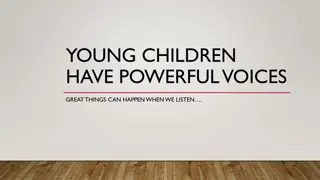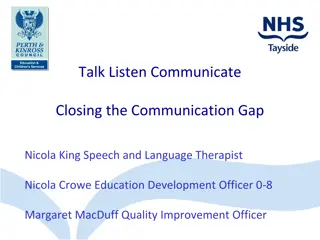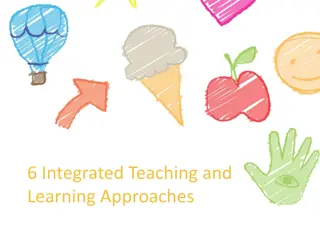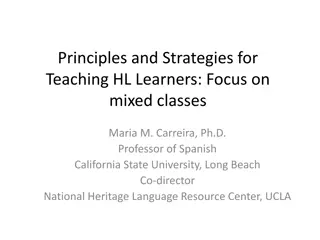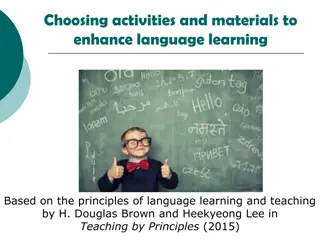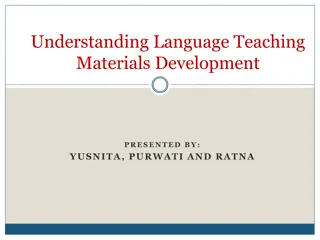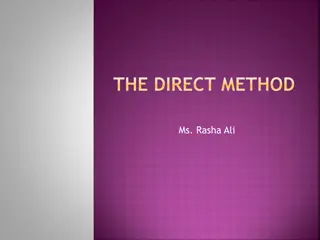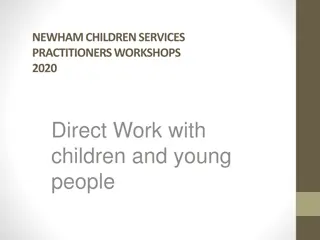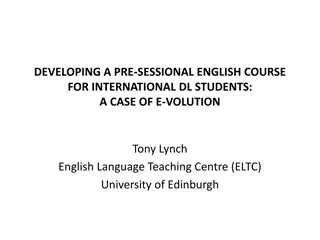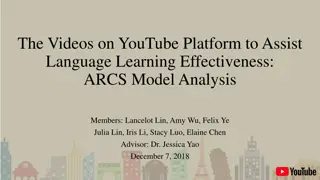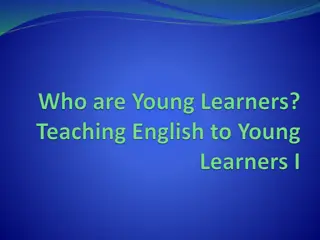Language Learning and Teaching Processes in Young Children
Development of language in young children is influenced by various factors such as their cultural and linguistic environment, unique characteristics, and interactions with adults. Optimal language development requires language stimulation from the environment. Varied cultural practices impact language learning, with differences seen in adult interactions, use of infant-directed speech, reading habits, and beliefs about child development. Socioeconomic status also plays a significant role, with low-SES children often experiencing slower vocabulary development. Mainstream Americans tend to view children as conversational partners and emphasize play in language learning.
Download Presentation

Please find below an Image/Link to download the presentation.
The content on the website is provided AS IS for your information and personal use only. It may not be sold, licensed, or shared on other websites without obtaining consent from the author. Download presentation by click this link. If you encounter any issues during the download, it is possible that the publisher has removed the file from their server.
E N D
Presentation Transcript
LANGUAGE LEARNING AND TEACHING PROCESSES IN YOUNG CHILDREN (chapter 6)
PowerPoint Outline** I. The Role of the Environment in Language Development II. Cognition and Language III. Toddler Learning Strategies IV. Adult Conversational Learning Techniques V. Print vs. E-Books for Young Children
I. THE ROLE OF THE ENVIRONMENT IN LANGUAGE DEVELOPMENT** Development of language rests upon several major variables that interact with one another 1. The child s cultural and linguistic environment is a big influence upon language learning 2. Each child has unique characteristics that she brings to the language learning situation
For a child to develop language optimally ** She needs language stimulation from her environment In many cultures, adult interaction with infants and young children differs from mainstream U.S. expectations
For example** Most American mothers use infant-directed speech: high pitch, shorter sentences, longer pauses, repetition However, other cultures may be silent with infants; children also may not be read to
According to your textbook, in some cultures it is believed that ** Children should be seen and not heard Children learn by observation, not interaction Comprehension is more important than production
Socioeconomic status makes a difference** Low-SES children s vocabularies may develop more slowly Being unsheltered--very negative impact Low-SES moms may not read as much High levels of prohibitions (e.g., no!! don t! ) result in poorer language skills for children
Mainstream Americans** View their children as conversational partners Believe in playing with their children
However, in an ASHA Leader article:** There was an article entitled From Couching to Coaching It was talking about what a lot of my former students have told me: when they do home visits for early language intervention, the parents sit on the couch on their phones and don t want to be involved they want the SLP alone to fix it.
The question was:** (p. 48 of article) How do we get families off the couch and working with us on improving the child s communication during mealtimes, tooth- brushing, and other daily routines?
ASHA Leader article why parents disengage:** 1. Believe home visit is time for Early Interventionist (EI) to take over 2. Don t see need to be involved in what EI does 3. Feel overwhelmed by child s special needs and believe they lack the training to make a difference
ASHA Leader article suggestions:** 1. Find out-what do parents want the child to do and when? E.g., be able to tell parent what they want to eat at meal times to avoid a tantrum 2. Realize that today, many parents don t get down on the floor and play with their children no time
ASHA Leader article:** Best thing: Use routines that parents already have to engage in multiple times a day Meal times, brushing teeth, getting dressed, diaper changes Weave communication tx into daily activities
ASHA Leader articlecoaching the parent involves:
Nature News 2022: https://www.nature.com/articles/d41586-022-00027-4
II. COGNITION AND LANGUAGE** Cognition and language are intertwined and develop in parallel fashion Cognitive skills are especially related to grammatical constructions like because and before & after
Word acquisition is guided by 2 types of knowledge structures** Event-based knowledge: sequences of events or routines that are temporal or causal and organized toward a goal
A child uses this event-based knowledge to form scripts** For example, if a child goes to daycare, takes swimming lessons, or goes to Sunday school, she has knowledge of those events they are a script for her Preschoolers especially rely on this type of knowledge
Taxonomic knowledge: Food Animals School items
III. TODDLER LEARNING STRATEGIES** A. Formula Verbal routine or unanalyzed chunk of language memorized units often used in everyday conversation Mark McKibbin at 2 years old: Thanks, and have a nice day!
B. Selective Imitation** Toddlers imitate a part of or all of an utterance Used in the acquisition of words, morphology, and syntactic-semantic structures Cute funny baby imitating his father (motions only)
C. Evocative Utterance** Child names entities; makes a statement Car. Adult gives evaluative feedback that confirms or negates what the child said Child then maintains or modifies meaning
D. Interrogative Utterance** The child is unsure of the word, and asks what s that? They are requesting information
IV. ADULT CONVERSATIONAL TEACHING TECHNIQUES** A. General Facts Children learn language faster when parents converse (as opposed to teaching and instructing) There are definite language-learning advantages for children who attend preschools where the curriculum emphasizes language and literacy
B. Expansions and Extensions** 1. Expansion: more mature version of the child s utterance in which word order is preserved Ch: Daddy drive. Adult: Daddy is driving.
C. Turnabouts** Utterance that both responds to the previous utterance and, in turn, requires a response Ch: We went to the zoo! Dad: Zoos are fun. What animals did you see?
Types of turnabouts are in Table 6.6 on p. 177 just know these:** Fill-ins (My dog likes to _______) Wh-questions (Why does the dog scratch himself? When do we eat breakfast?) Yes-no questions (Do you think the dog has fleas?)
Summary of new research on child-directed speech:** Amount of talk directed to children from 0-3 years predicts academic success at ages 9 and 10 yrs. old Parents of language-advanced children spoke much more to those children than parents of less-advanced children
The more TV in a childs day** The lower her language scores
**Christakis and colleagues studied the impact of TV and its noise on parent-child interactions in homes
Christakis et al. found that:** Each hour of audible TV was associated with significant reductions in: 1. Child vocalizations, vocalization duration, and conversational turns 2. Adult male and female word count
Constant noise in the home is also associated with:
Devices like phones make a difference too:** More people on earth own a mobile device than a toothbrush The average person has a 7-second attention span; a goldfish has an 8 second span
V. PRINT VS. E-BOOKS FOR PRESCHOOLERS** A. Premise The American Academy of Pediatricians (2020) clearly states little-no screen time for children from 0-2 years, except for video chatting with relatives Research shows that school-aged children may benefit from e-book advantages (e.g., dictionaries, highlighting key words)
In terms of paper vs. e-books books for preschool children (2-5 years)** Research is mixed E-books--more exciting, initially engage children s attention more effectively than paper books
But.** What is their effect on dialogic reading and children s comprehension? Dialogic reading: interactive reading between caregivers and children
Disadvantages: (Willoughby, Evans, & Nowak http://www.eetconference.org/wp- content-uploads/
Parrish-Morris, Mahajan, Hirsh-Pasek, Golinkoff, & Collins. Once upon a time: Parent- child dialogue and storybook reading in the electronic era. Mind, Brain, and Education, 7(3), 200-211.** Studied 165 parent-child dyads reading e-books and traditional paper books Children s story comprehension and parent-child dialogic reading were negatively affected by the presence of electronic features
ASHA Leader:** Cited a study done at University of Michigan Children s Hospital bit.ly/print-books
ASHA Leader** Recorded videos of parents reading to toddlers in 3 conditions: 1. Basic e-book (no sound effects or hot spots) 2. Enhanced e-books (e.g., with sound, animation) 3. Print books
ASHA Leader articleNumber of children s verbalizations during reading
Dr. Perri Klass: Journal of the American Medical Association, parents and children 10-16 months of age
2024 Journal of the American Medical Association https://jamanetwork.com/journals/jamapediatrics/ar ticle-abstract/2813443** Analyzed data for 1471 children (# of children not on the test) They studied screen-viewing data for the group at 12, 18, and 24 months old At 33 months old, assessed children s sensory processing
In the JAMA 2024 study,they studied atypical sensory behaviors such as** Sensation seeking Sensory sensitivity Sensation-avoiding Low registration (slower to respond to stimuli)





